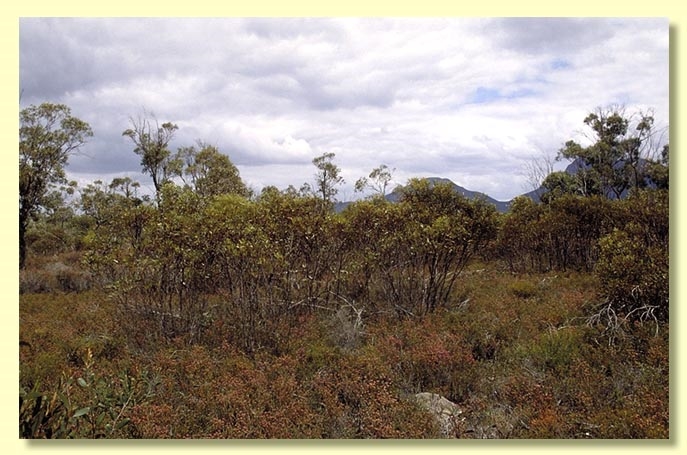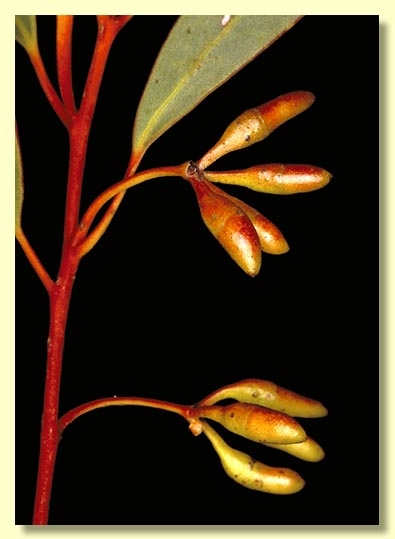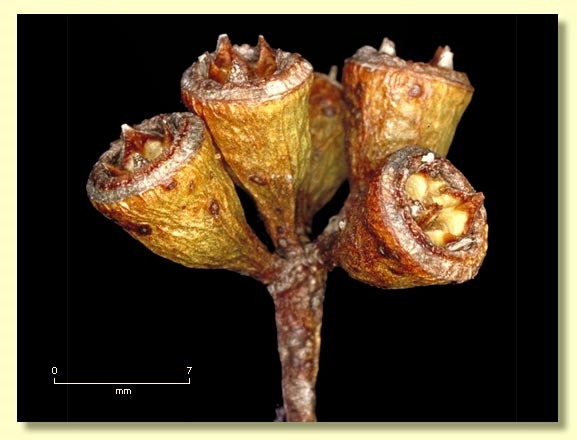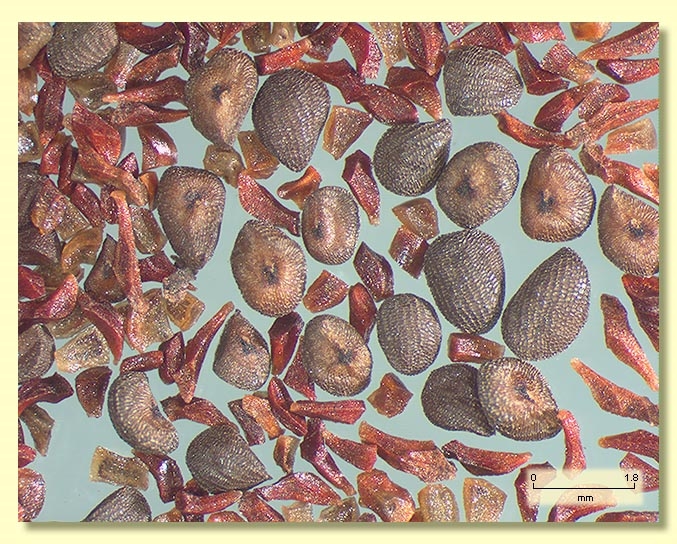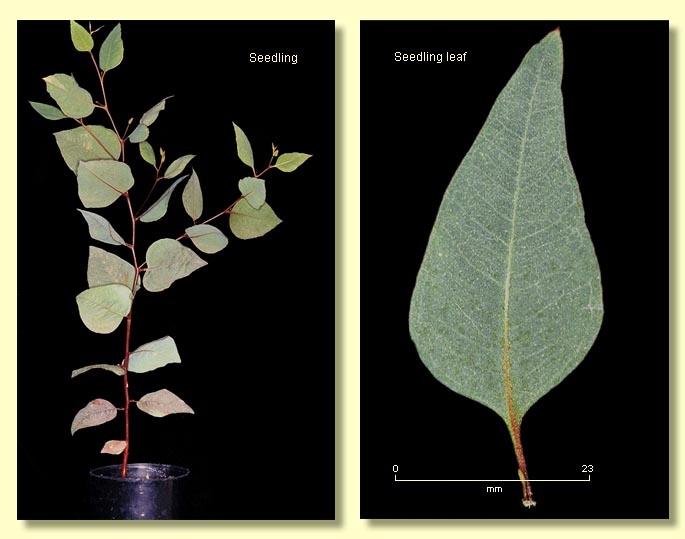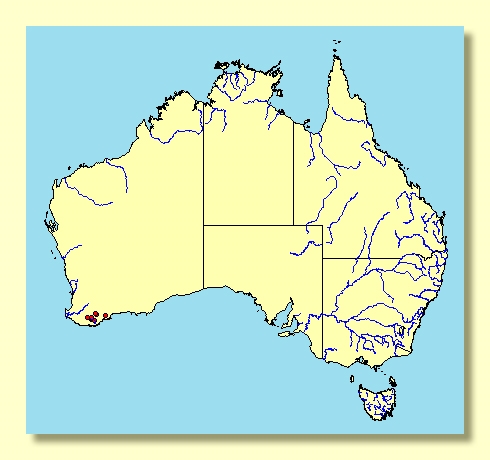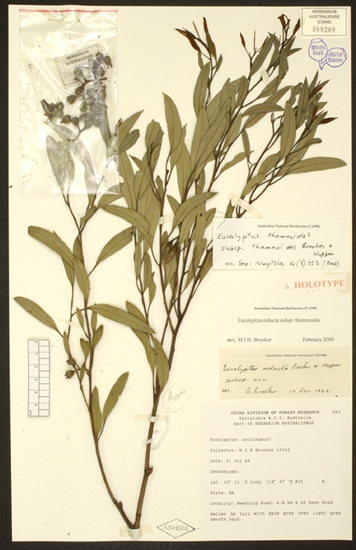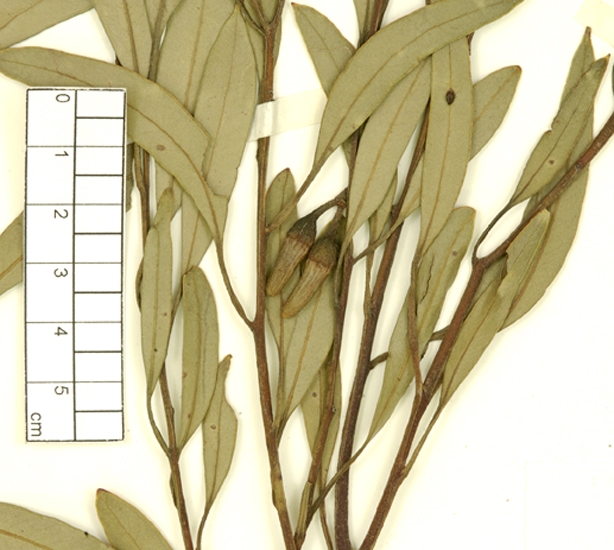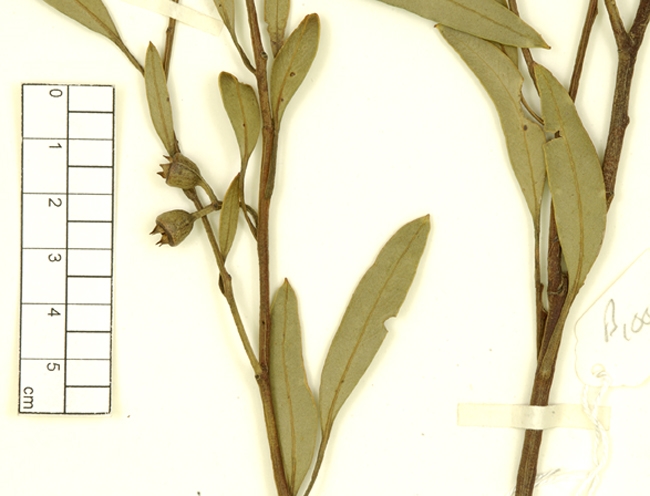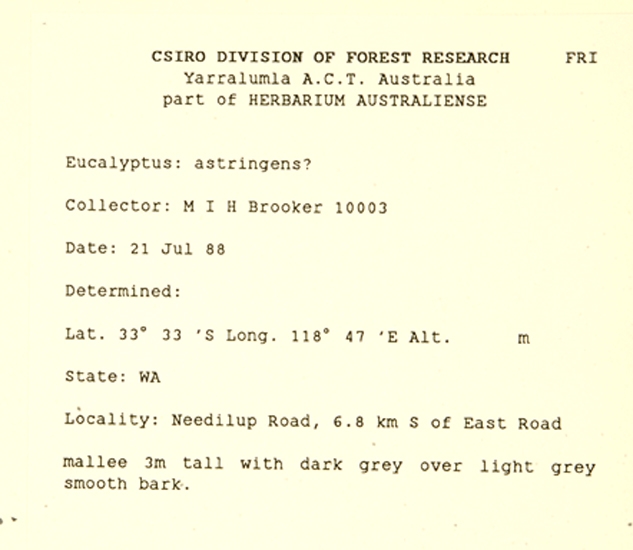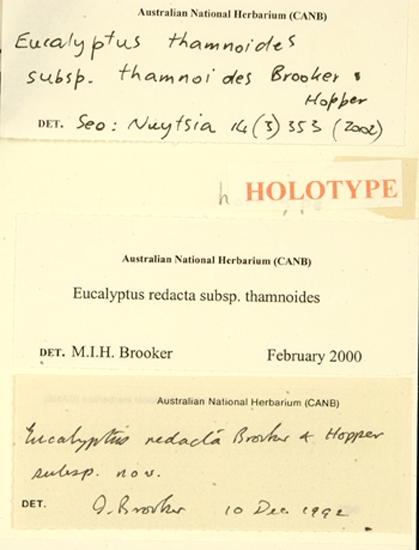Eucalyptus | Symphyomyrtus | Bisectae | Glandulosae | Erectae | Pedicellatae
Euclid - Online edition
Eucalyptus thamnoides subsp. thamnoides
Bark smooth throughout and pale grey over pink-copper and white, rarely partly rough with imperfectly shed basal ribbons of brown or grey bark.
Branchlets have oil glands in the pith.
Juvenile growth (coppice or field seedlings to 50 cm): stems rounded in cross-section; leaves always petiolate, alternate, lanceolate, 4–10.5 cm long, 1.2–3 cm wide, dull, grey-green to green.
Adult leaves alternate, petioles 0.8–2 cm long; blade lanceolate, rarely falcate, (4.5)5–10.5 cm long, 0.8–2 cm wide, base tapering to petiole, margin entire, apex pointed, concolorous, green, at least slightly glossy, side-veins at an acute or wider angle to midrib, reticulation moderate to dense and broken, intramarginal vein present, oil glands numerous, island and intersectional.
Inflorescence axillary unbranched, spreading to erect, peduncles more or less flattened, 0.8–2.5 cm long, buds 7, pedicellate (pedicels 0.2–0.5 cm long). Mature buds elongated-ovoid (1.3–1.6 cm long, 0.3–0.6 cm wide), flared at the join of operculum and hypanthium, scar present (outer operculum lost early), inner operculum bluntly horn-shaped, ca 1–2 times the length of the hypanthium, stamens erect, anthers oblong, versatile, dorsifixed, dehiscing by longitudinal slits, style long and straight, stigma blunt, locules 3 or 4, the placentae each with 4 vertical rows of ovules. Flowers creamy white to pale lemon.
Fruit erect to spreading, pedicellate (pedicels 0.1–0.6 cm long), cupular to obconical or campanulate, 0.6–0.9 cm long, 0.6–0.8 cm wide, disc level at first then descending, valves 3 or 4, held at rim level or exserted.
Seeds blackish brown, 0.8–2 mm long, ovoid to flattened-ovoid, dorsal surface shallowly reticulate, hilum ventral.
Cultivated seedlings (measured at node 10): cotyledons Y-shaped (bisected); stems rounded in cross-section; leaves petiolate, opposite for 3 to 5 nodes then alternate, deltoid to broadly ovate, 4–7 cm long, 2–6 cm wide, dull, grey-green to green.
Flowering has been recorded in April, June and November.
A mallee species endemic to Western Australia, found from west of Quairading south to the Stirling Ranges and east almost to Hopetoun, on sandy-clay or gravelly soils, not on breakaways. Bark is smooth throughout, (rarely with a very short stocking of rough bark), and crown leaves glossy green with some reticulate venation visible.
Eucalyptus thamnoides belongs in Eucalyptus subgenus Symphyomyrtus section Bisectae subsection Glandulosae because the buds have an operculum scar, cotyledons are bisected and branchlets have oil glands in the pith. Within this large subsection (ca 80 species), E. thamnoides is closely related to a group of mallets and mallees (series Erectae subseries Pedicellatae) recognised by the glossy green leaf surface, leaves with many oil glands but not obscuring the secondary venation, peduncles long and flattened or terete, inflorescences spreading to pendulous and buds with operculum longer than the hypanthium (base) and erect stamens arising from a narrow staminophore.
Eucalyptus thamnoides differs from the closely related species E. astringens only in its mallee (not mallet) habit and in habitat preference. Both species have stubby buds with the operculum only one to two times the length of the hypanthium, and campanulate fruit. Other closely related species, viz. the rough-butted tree of freshwater creeks and depressions E. occidentalis, rough-barked mallee E. aspratilis, smooth-barked mallee E. sporadica and usually rough-butted tree of saline sites E. sargentii subsp. sargentii, all have more slender buds with elongated opercula. (The other 3 species in subseries Pedicellatae, E. sargentii, E. diminuta and E. stowardii all have more or less terete peduncles that don't widen apically).
There are two weakly separated subspecies:
E. thamnoides subsp. thamnoides
This has smaller buds and fruit (fruit 0.6–0.8 cm diameter) than subsp. megista, and occurs south from Gnowangerup to the Stirling Ranges and east to Needilup and Jerramungup.
E. thamnoides subsp. megista
This has fruits from 0.8–1 cm diameter and occurs from near Quairading south to Cranbrook and extending in an arc east to Corackerup and Hopetoun, including Fitzgerald River National Park. It is absent from the Stirling Ranges. Mallees from near Bremer Bay to Boxwood Hill may have some basal rough bark but otherwise match this subspecies. (Herbarium specimens annotated with the manuscript names "E. astringens subsp. oligocorma" and "E. oligocorma" are now correctly E. thamnoides subsp. megista).
E. thamnoides subsp. thamnoides and subsp. megista have only been recently described. More field investigation is required to clarify their overlapping distributions, especially in the area immediately north of the Stirling Ranges east to Needilup. Further work may indeed show the two subspecies are not really distinct.

